It’s hard to tell who is who in the dark. Only a few colored lights occasionally light the hallway where more than fifty people are partying. They are jumping, dancing, changing partners, sweating, touching or hugging each other. A raucous reggaeton, a bachata or an old bolero in the background emanate from two black handmade baffles, each one a meter high and placed right at the entrance as a welcome to this night.

Dale cintura / Paʼ arriba y paʼ abajo / el pasillito loco / sube una mano
Already alcohol has already begun to take effect. The dance has become a combat in which there will be no winners. The hitched up t-shirts leave the muscles of the abdomen exposed; this is a basic requirement to impress others. The first competitor moves his body in a wave-like motion, squats down in a semi-squat and locks different muscles to the rhythm of the music. The second one combines arms and feet at a speed that looks like a desperate flapping, as if he were going to fall to pieces. Another one throws a handkerchief and picks it up with his mouth without touching the floor. The first one is lying on the floor. They climb on top of him, pushing each other. All around, the others watch, shout and pass judgement on what they are seeing. The children imitate the grown-ups.

Talento tengo yo / oye, oye / talento tengo yo
It’s Friday, but it could be Tuesday or Sunday in the farming community Pedro Soto Alba. For those who work in the fields it makes no difference, for those who don’t, less so.
Yakelín Rodríguez takes a few seconds to catch her breath. She looks around and hides her exhaustion. She has been dancing and walking for hours. Her hair is loose and wet. Her red blouse exposes her belly. As one of the organizers, she leads by example. Her son is one of the dancers. This is a party to have a great time.
It is not just any party: it is the anniversary of the Committees for the Defense of the Revolution (CDR), the largest mass organization in the country, and she is the president of the CDR of this community. Although here any pretext is as good as any to celebrate.
The smoke of burning charcoal clouds the atmosphere. A few hours ago Yakelín collected money from the neighbors, cleaned the floor of the central hallway —now being used as a provisional dance floor— and, most importantly, peeled the vegetables for the caldosa that still boils above the improvised fire.

Oh, yes, the caldosa, the magic potion. Since 6 o’clock in the evening they began to prepare this broth of vegetables and some pork with seasonings (usually bone, head or some meat). It resembles the typical Cuban ajiaco, a traditional dish of the national cuisine that mixes pre-Columbian, African and Creole cultures. Don Fernando Ortiz, in 1939 in his famous work Los factores de la cubanidad, writes that “the image of the Creole ajiaco is a good symbol for the formation of the Cuban people. The island of Cuba is a pot put on the fire of the tropics.” The caldosa, daughter of scarcity, is cooked with all the ingredients together from the beginning. You simply throw in anything you can find and then it is cooked slowly, uncovered, in a collective cauldron almost always over charcoal and in the middle of the street, until everything is well integrated and the broth has thickened.
As the caldosa takes more than five hours to cook, Yakelín, her husband Raidel (or Carnation, as they call him), her nephews who are visiting, Aylín Carrasco —her neighbor— and some other people started working on it since earlier in the day, all seated on one of the stairs leading to the outside areas. Children of all ages also helped as they ran around the place and went into the cellars. One of them was Angélica, who is nine years old and has been living with her grandmother since her mother was taken to jail. But tonight she’s not thinking about that, she’s just dancing like everyone else. The main ingredients of today’s caldosa are, above all, yucca and pumpkin.
Mira cómo tengo a mi Cubita / Dale cinturita con la puntica / Puntéalo, puntéalo…
Here you have to move around to avoid the mosquitoes and the heat. It hasn’t rained for days, but in the small hours, in the countryside, the humidity combines in an unbearable torpor that makes you sweat, even if you are sitting down. That’s why Yakelín and Aylín in the middle of the dance floor move their bodies, their heads, shake their hair, their buttocks, everything that can be put in motion at the same time. Almost crouch down, head forward, the world revolves around them. That’s all that matters now.

Inland
Pedro Soto was one of 131 schools closed in 2010, when the government changed the educational model and moved the students from the countryside to urban centers. The former Pedro Soto Alba Polytechnic School of Irrigation and Drainage was abandoned until its conversion in 2014 when three exterior staircases were added and the property was transformed. The building in front, three-stories high, formerly housed classrooms; and the one in back, four-stories high, was where the students lived during the week.
The buildings were converted into housing for seventy-five families who, in return, took on the obligation to work in the fields for fifteen years.
Today, however, it looks like a place abandoned to its fate: lonely, unpainted, condemned to neglect. A mass of concrete that looks imposing and is out of place in the middle of the fields that surrounding it. The hanging clothes, the movement of people and the music that never stops playing are the only elements that indicate that it is an inhabited place. The construction project carried out by the Empresa de Cultivos Varios de Melena del Sur at the old school only took care of the housing. Although they initially planned to include a park, a doctor’s office, and a market, all this ended up in nothing. Today there is a public telephone and a store. There is neither street lighting nor refuse collection.
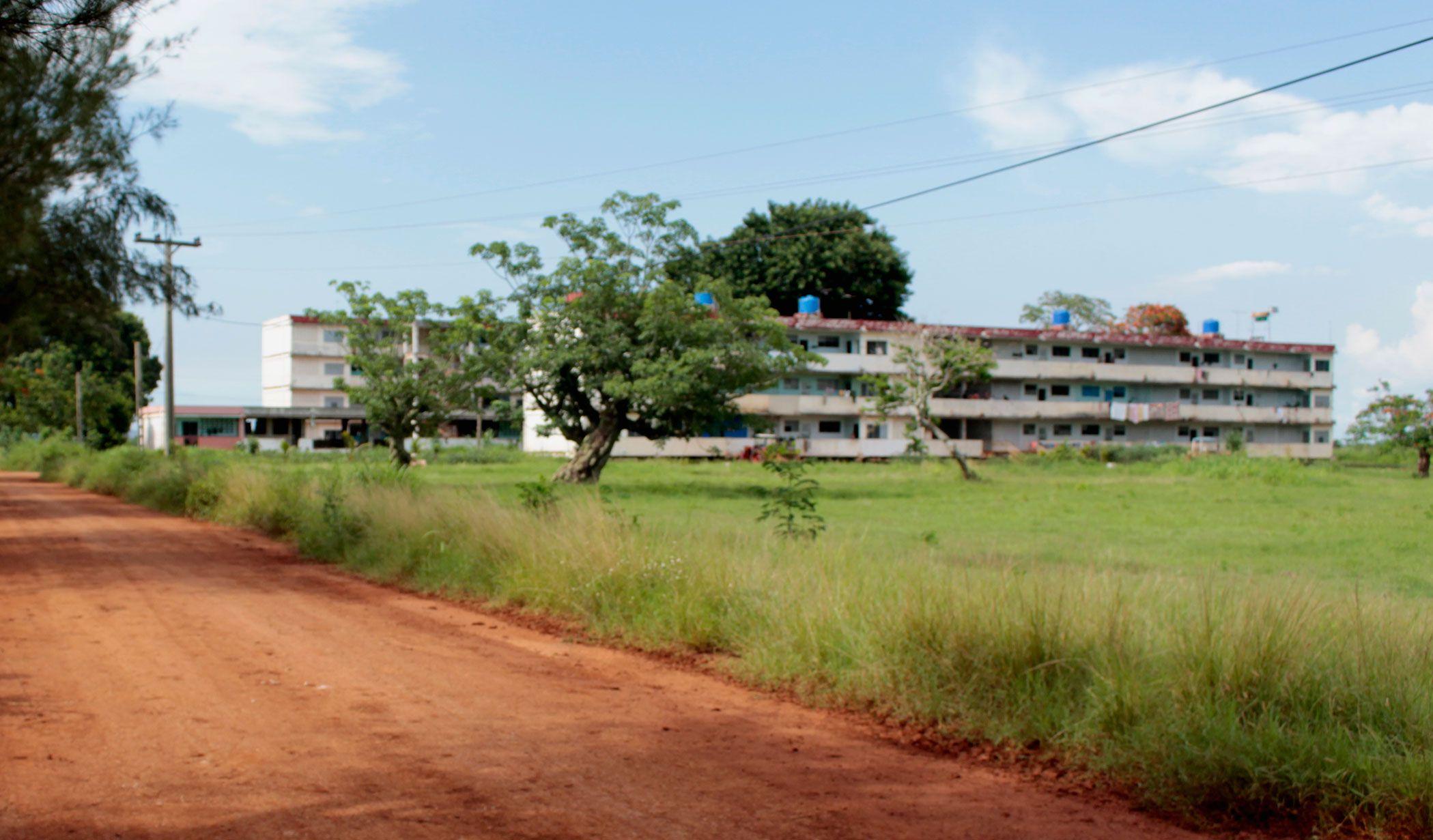
We are fifteen kilometers inland from Mayabeque Beach on the southern coast of Cuba. This is an agricultural municipality that supplies fruits and vegetables to the capital. The community is five kilometers away from the road that connects the municipal capital of Melena del Sur with the nearby municipality of Güines, in the province of Mayabeque. If you arrive on foot from there, you have to cross large extensions of cultivated land and pass in front of the local prison.
The greatest achievement of these lands is to have been the first territory free of illiteracy in the country. It is a well-situated area, but in it the urban settlements are distant from each other. Even today, as in the 19th century, animal traction —or bicycles— is the dominant means of transportation in the locality.

In Pedro Soto Alba, during the week, buses run every three hours until 6 o’clock in the evening. You can also get private taxi, but only at departure points, and Pedro Soto is located midway. From the road you can see the two H-shaped, prefabricated concrete buildings connected by a wide corridor and interior stairs.
Up close, Pedro Soto Alba is identical to all the schools in the countryside built since 1970 in Cuba with the method baptized Girón by the then Department of School Works of the Ministry of Construction. A more economical design, symbol of the new schools in rural areas where students would combine study with agricultural work. “This is the new school, this is the new house, new house and school, as a sign of a new race” the troubadour Silvio Rodríguez would sing then. Large-scale agriculture was a social undertaking and today it is still an unsolved problem. Food self-sufficiency is considered by the government as a matter of “national security.”
Yakelín lives in apartment 206, second floor on the right in the first building. Aylín is her neighbor: a wall separates both apartments.
Like most people here, Yakelín is a migrant. She was born in Manuel Tames, in Guantánamo province, in the far east side of the country. She spent 13 years living in a camp associated with the Manuel Isla cooperative —one of the two to which the housing was assigned— and working in whatever was needed: sweeping, picking up trash in the cooperative, cooking, etc. While the construction lasted, she was the custodian of the site. Since she moved in, she has been unemployed. She says that she has tried several things but ends up quitting, that in the end it eats a lot of money in transportation, that she has to take care of the house and that she can’t make ends meet. She has tried her hand at cooking and has also taken a course as a cigar maker, but none of this really interests her.
It is the same with religion as with work: she says that she is a fanatic of God, that in her family everyone believes, that her father and brother practice the Afro-Cuban religion, but that she went to the Jehovah’s Witnesses and then to the Pentecostal Church, and that everything seemed hypocritical to her. In a corner of the room she has flowers and candles dedicated to Elegguá, “the opener of roads,” one of the seven fundamental gods of the Yoruba religion.
Yakelín and her husband, the cooperative’s brigade leader —but he often works for 50 or 60 pesos for the private farmers— want to raise animals. The company and the government do not allow them to set up collective pigsties in the community for hygienic reasons, due to the lack of adequate infrastructure, and to avoid water costs. Nor can they take advantage of the vacant land surrounding the community.
Pedro Soto Alba could be any peasant community in Cuba, far from the city, from cultural life, from the media, a place invisible to the eyes of others where every day is the same as the other. A place where nothing happens.
Fighting with the whole world
The tone of the party rises. The number of dancers increases. The music has not stopped playing. Alexander is the owner of the equipment and the DJ on duty. He lives in the ground floor hallway below Yakelín. Tonight he is sporting, like most men, his bare torso.

Estoy fajaʼo con toʼ el mundo / Yo soy tremenda pieza / Ehhhh
It is not possible to identify who are together as a couple. People dance very close to each other, changing partners every so often; but you don’t see people kissing in public or holding hands or looking at each other affectionately. Love has a more practical dimension, earthlier, more of conquest.
Carnation, Yakelín’s husband, is not in the hallway or dancing. He is sitting in front of the caldosa and stirs it from time to time. He has not taken a shower nor is he dressed for the party, he is barefoot and a bottle of rum has kept him company since the afternoon in his mission to watch over the stimulating and aphrodisiac mixture “capable of raising a dead man.”
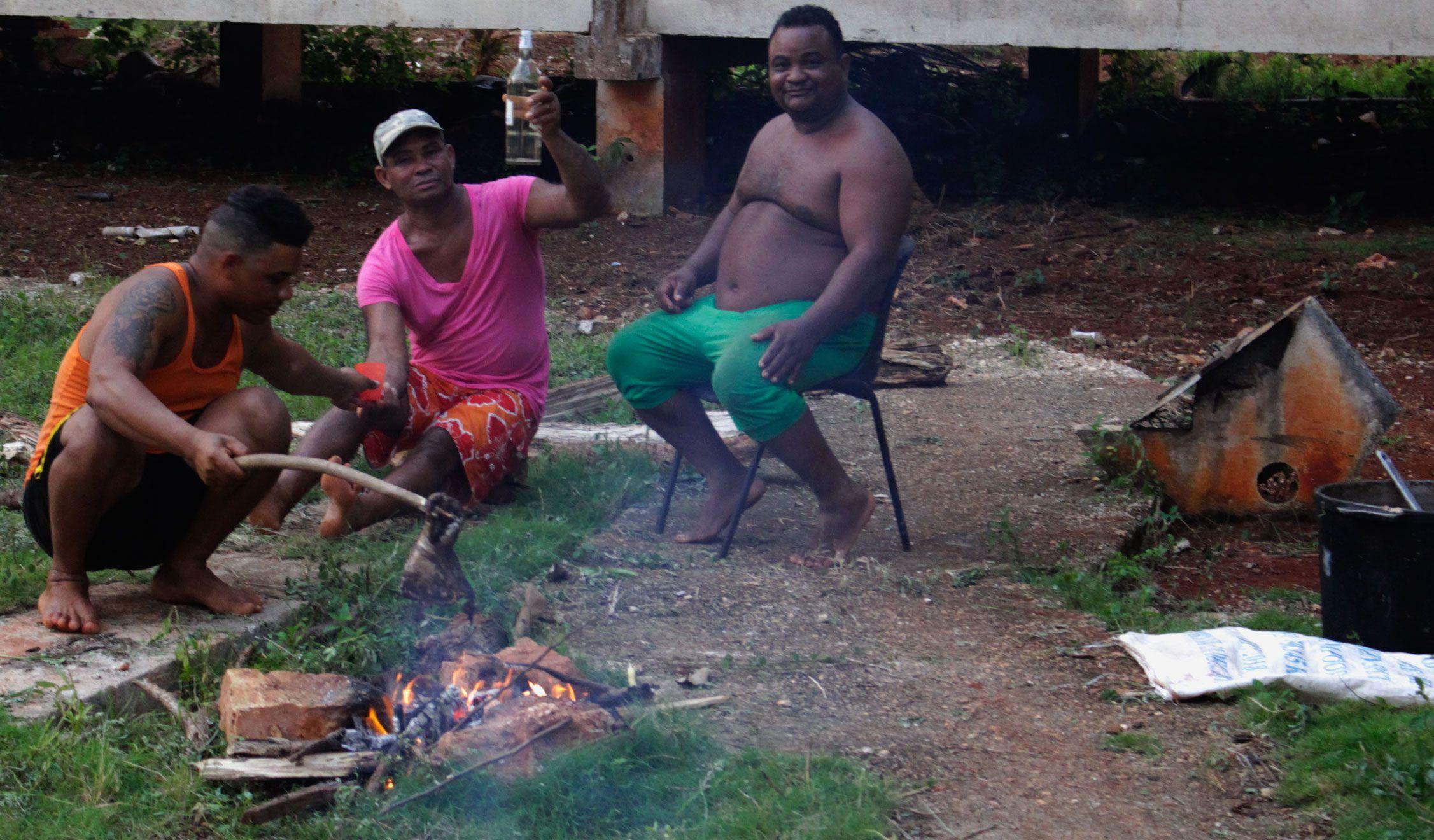
It doesn’t matter that there is no water or anything to eat, there is no need either. Beforehand, for the children, soft drinks and cookies were handed out. The essential fuel here is alcohol and the prize will be the caldosa.
This name became popular in Cuba thanks to the guaracha that Rogelio Díaz Castillo dedicated to the recipe prepared in 1979 by Kike Pérez and Marina Zaldívar at a community party in La Tunas, the province where eastern Cuba begins.
One Thursday Doña Lolita gave caldosa to Pirindingo,
and kept him dancing from Thursday to Sunday.
Look, Don Kike, look, Marina, with this caldosa, how well you walk.
How well you walk, how well you walk, because this caldosa has a hen in it!
A few meters away there is another loudspeaker playing different music and another caldosa. There are supposed to be two CDRs in the community. That is why today there are two celebrations and neighbors can choose, at times, in which place they prefer to be. Which caldosa will taste better?
Fidel Castro created the CDRs to, according to the official discourse, organize people in their communities and defend the Revolution from acts of interference. They are organized by place of residence and each grassroots structure is composed of approximately 150 people. After its founding in 1960, they coordinated citizen mobilizations and a neighborhood watch system. However, although it is the largest organization in the country and its main representative is part of the Cuban State —specifically one of the twenty-one members of the Council of State— its real power to summon people and its incidence in society has been reduced to formal spaces, such as this anniversary party.
With the Federation of Cuban Women, the official organization that groups women, something similar is happening. In Pedro Soto, Aylín is its representative, she is thirty years old and has no job either; but she is not worried about this: she says she would like to leave the country, that her future is not in this place.
She sits next to me for a moment on one of the benches in the hallway. She has stopped dancing to smoke a cigarette. She talks about her debts —she has to shout because the volume of the music is too loud—, about the fourteen-year-old boy who lives with his grandmother in the eastern side of the country and about the foreigner who recharged her phone the other day. She has already put Hip Flask to bed —Carnation nicknamed him that—, her three-year-old boy, who fell asleep in her arms after running around all afternoon.
Almost all men here have a nickname, a social personality imposed by others and assumed with pride.
Caldosas made with dog, cat meat, anything
“It’s like the Eastern provinces here. When they play music, they don’t let you sleep with the all the noise, but who’s going to regulate that if the Sector chief doesn’t even come around here. About three days ago at 11 o’clock at night, I was pouring a coffee and I had the door open, I saw a guy looking in. I quickly ran after him and caught him on the third floor. What he wanted was to steal.”
It is Juan Estrada, “el Jabao,” talking. He is a plumber, works for the municipal government and was the last one to arrive in the community. His house is still under construction. He spends his time leaning against the wall of the porch, looking at the horizon. When you arrive in the community, this is one of the first sights that greets you.
Cuba is divided into fourteen provinces that coincide along the horizontal line with the western, central and eastern regions of the country. They have different levels of social development, historical conflicts and cultural differences. In the west is the capital of the country, where national life is decided, where the main tourist poles are located and where there is a greater diversity of labor options. To the east are the main mountainous areas and access to culture and education is more limited.
In the east, closer to Haiti and the Dominican Republic, there is a higher percentage of black and mulatto population, and the Caribbean overflows in music, food and a way of speaking with a lilting, rhythmic accent. The west, very close to the Florida coast, has always had an eagerness to “progress” in the style of its closest neighbors, even when the political differences between Cuba and the United States have created an abysmal distance.
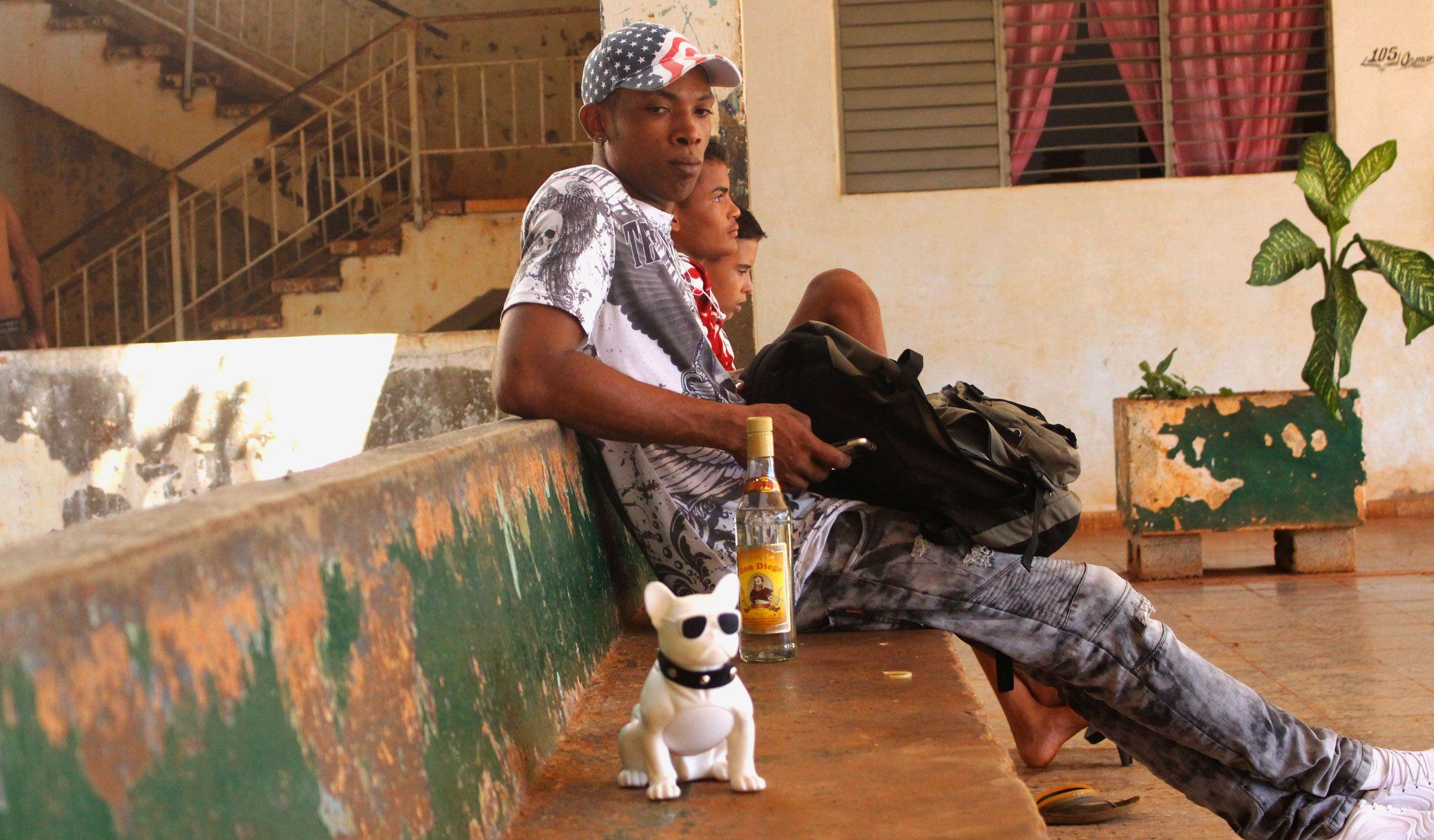
These long-standing racial, social and economic differences have brought about a migratory wave from East to West, especially from the most marginalized sectors, the people living in the most precarious conditions, and have accentuated the existing prejudices between the regions of the country.
“Most of the people who live here are from the East, and sometimes there are many who come for family celebrations and stay longer, or people who come on vacation,” says José.
Although the rules established by the Company say that permission must be requested for visitors to stay here, the exact number of people who spend the night each night in the community is a mystery.
“Here, 300 go to bed and 500 get up the next day. On top of that, there are many who are not very hygienic, who come from the camps and continue with the same habits.”
José Ponce was born in Old Havana and was appointed administrator, the person in charge of looking after the Company’s interests.
“My job is to make sure they don’t mess up the building, to keep the electrical rooms under lock and key, because if you let them, they will remove the aluminum windows and sell them. Could you imagine that there was a man who sold the patio door because he said he didn’t need it?”
Each house has a holder in whose name is the contract. The document states that they cannot change anything they have received: their new house is not theirs. Not yet. The Company looks after the property and deducts from the salary the payment for the housing, on average about fifteen Cuban pesos though the amount varies depending on the number of rooms, while retaining the responsibility for the maintenance and repairs of the place.
In Pedro Soto the apartments are spacious, the spaces are well distributed, and all of them have two or three rooms, bathroom and kitchen.
The remodeling of the place was executed by the agricultural group GELMA for approximately two years and cost three million Cuban pesos (at the state exchange rate at that time, one Cuban peso was equivalent to one dollar). This community is one of the twenty-one schools that, according to what Gustavo Rollero, Minister of Agriculture, explained in the Round Table program, have provided 1,706 houses for agricultural workers throughout the country.
They all agree that they were very happy the day they moved in. On December 5, 2014, they already knew which house they were getting and had come several times beforehand to clean it. So when the trucks arrived at the cooperative at 10 a.m. and announced they were picking the people up, all hell broke loose. At 4 o’clock in the afternoon, the building was inaugurated. Present at the inauguration were the Party Secretariat and the Company’s directors.
“It is not the same to live in a camp than in a house, where you have your personal bathroom, your privacy. There are people who have been working and living in the camps for up to twenty years. In the camp, good or bad, there was breakfast, food and comfort, but we were anxious to have a house,” recalls Yakelín.
“The problem is that pieces of wall fall down, tiles break, and the pipes leak. After three years the Company should have provided maintenance; five years have passed and it has not even been possible to paint the front of the building,” explains José.
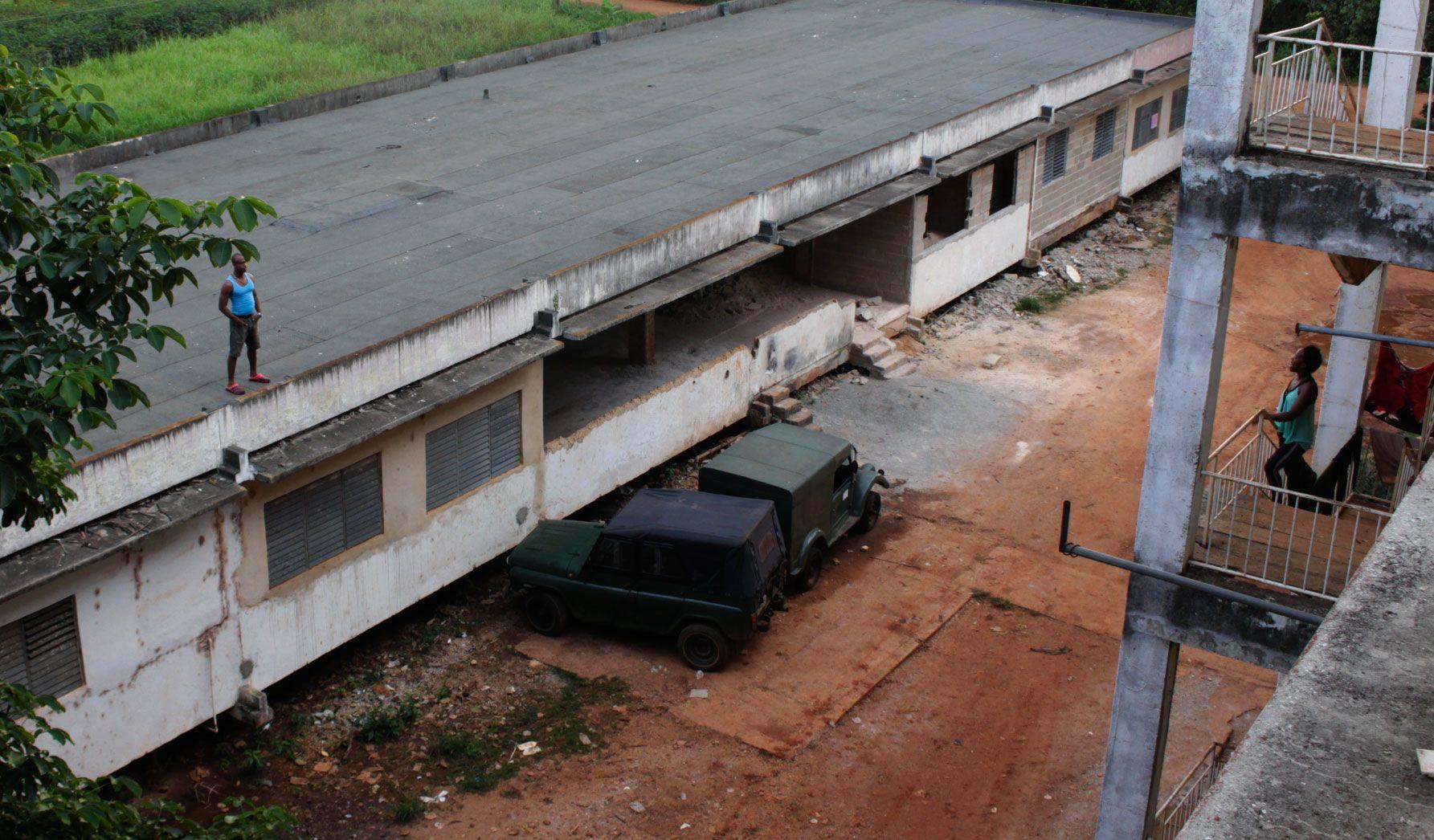
The initial enthusiasm settled and although everyone is grateful to have a house, problems have started to appear, inside and outside. Living in a community and adapting to the rules of the collective game is another matter. Personal customs and tastes, accumulated education, security, interests, support, recreational spaces —as in a school, when you are the new student— have to be woven little by little.
Now and for many years, neighbors would also be friends, co-workers, bosses, it involves political militancy and all forms of social participation too. It all comes down, fundamentally, to the same people, sharing the same physical space, all the time.

“They told us that we could not enlarge or modify the house; but imagine that neither the stove nor the pots and pans could fit on the counter. There were two tiles on this side, the sink and two tiles here,” says Yudmila Hernández (Yumi).
Her house is on the fourth floor of the second building and her door is always locked. It is one of the nicest houses in the area. She has fixed it up and painted it several times. All the windows are covered with different colored curtains and a large rug covers the living room floor. There is no shortage of comfortable furniture or essential appliances. The biggest luxury in her house is a liquid gas balloon for cooking, in a place where at best people cook with electricity, but it can also be with firewood, kerosene or any other flammable liquid.
Yumi is known as the Blonde, because for a long time she was the only white woman with blonde hair living in the community. She worked for the Company and has five years of service in the municipal Party. She had a small house before she moved there, but longed for her two children to have a room of their own.
“What’s wrong about this place is how uncultured the people living here are, also how dirty everything is, and the music they play all day long that doesn’t even let you watch TV. It doesn’t matter if it’s 2 o’clock in the morning on a Monday and you have to go to work the next day, they don’t. The authorities have come and told them a lot of things and nothing ever happens.
Yumi is not the only one who complains about living together. Blanca, an elderly woman who lives on the ground floor, right next to the staircase where they usually play music, does too. But she is more radical:
“If there’s a party, some people end hurt, there’s trouble, someone ends up being stab. That’s what I say: don’t allow parties! If you want to listen to music, play your own music in your house. I don’t care if they call me a snitch or whatever they want. I went to the police and I brought it up. I told them: they don’t let you sleep there. It’s 1 o’clock or 2 in the morning and they’re playing dominoes, partying and listening to music. They make caldosas with dog meat, with cat meat, anything… If their mother dies, they also celebrate,” says Blanca.
Neither Yumi nor Blanca go to the parties. Yumi says that even if they are among family, they end up in a fight.
Tríquiti over here
“Tríquiti over here.”
This is said by one of the four players currently seated at the table as they have been taking turns to play dominoes all night. He throws down the domino and shakes the glass of rum sitting on the edge of the table.
“Here there’s everything, dude, and you know I’m the man,” replies another as part of the usual rude banter.
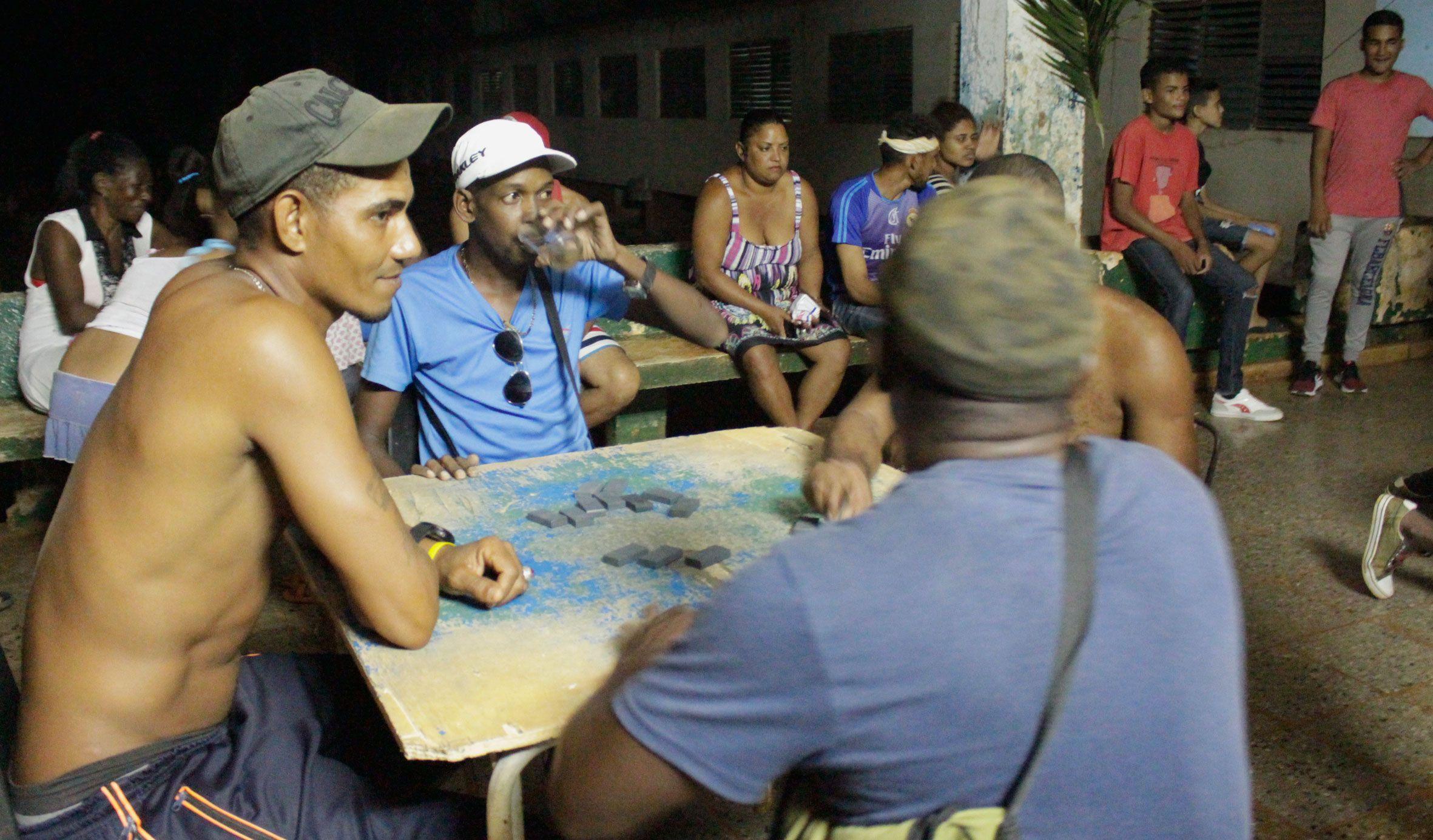
The table where they are playing dominoes occupies the center of the corridor. The light bulb that was taken from a house just for tonight is now on. All the players are men. Since only four people can play at a time, and the game is played to a hundred points, while others dance, some take turns around the table to do something different.
The younger ones sit on one of the stairs and share a glass of rum. There are boys here who came from Cantón, a community of thirty-five houses that is right next to Pedro Soto, and visitors from Lechuga, a town two kilometers away, sometimes come here as well.
Blanca looks out of the window and tries to close it to prevent the music from penetrating, but it is impossible. Even against her will, she is also taking part in the festivities.
Yakelín and Aylín dance with several men. Alexander, as DJ, plays the music people ask him to.
Las putas no tienen dueño, ni jefes ni na’ / Las putas son del que venga y les dé con maldad
This party is a struggle against everyday life, a systematic habit that occupies the time and distracts them while keeping a distance from the outside world.
The stairs of the well-fed
Time makes obvious the differences between those who can afford to fix up their house and those who cannot. It is also a reflection between those who work and those who do not.
“When I moved here, from the fourth floor down, I was the only one who hosed down the stairs. Even the men would hide from me so they wouldn’t have to connect the hose so I had to carry buckets of water. Now I just sweep them and that’s it, because nobody cares,” says Yumi.
The staircases in Pedro Soto are a space for socializing, an important place and they even have names: at the back is “the devil’s stairs,” because in that area there are several families that practice the Afro-Cuban religion and organize toques of saints. On the other side is “the stairs of the presidents,” because several managers used to live in that area. In the front, “the stairs of the bare feet,” which leads to the houses of Yakelín and Aylín, among others; and “the stairs of the well-fed,” where José lives. On this side, most of the people are natives of this area of the country and have better housing conditions.
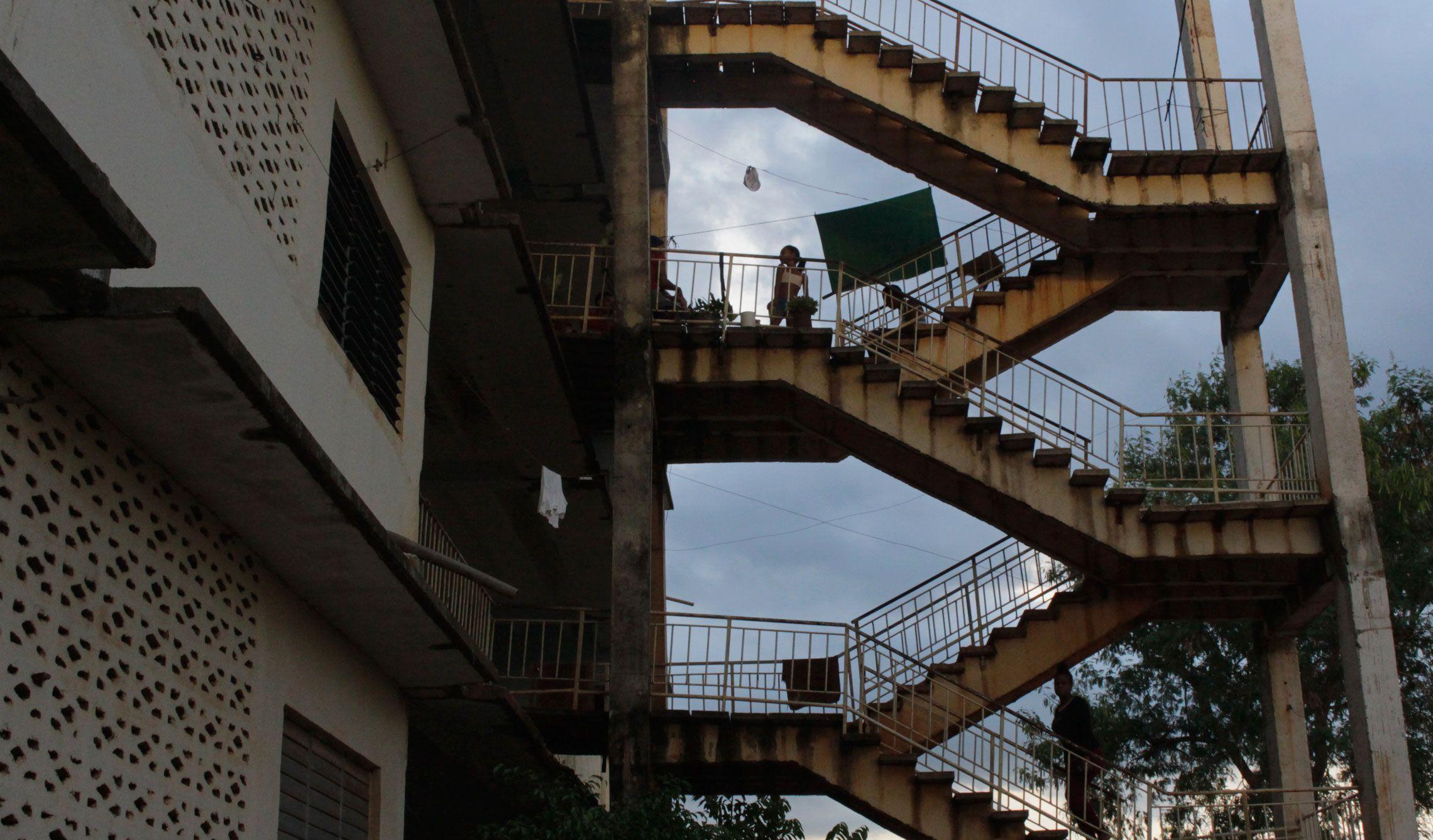
A year after the move, the stairs of the well-fed collapsed, but that did not matter much either. The ones that are still standing are barely holding up. The concrete fragments that make up the steps are breaking off and coming loose little by little every day, just like the houses.
The wear and tear of the installations is assumed to be a natural occurrence. So everyone talks about the fall of the staircase, but no one remembers the exact date when it happened: they only know that it was a sunny day during the week.
In thirty seconds, they say, it fell as if it was pushed and fell apart in slow motion. They were looking for Heberto in the rubble. It was 8:40 in the morning and he had gone up to José’s house for coffee. His wife Gladys was at the door of their apartment, 301, on the ground floor, and on the balcony on the other side Yakelín and Aylín were talking.
“I had said that the stairs would not last ten days, because it had a loose leg, and they told me that a bag of cement would fix it. I said that it wouldn’t solve anything to cover something that wasn’t properly fixed; it didn’t have any kind of fastening nor was there any welding, the rebars were point to point,” said Heberto. “I thought José had thrown a pebble at me, but when I looked up he was not on the balcony, he had gone inside. So, I said to myself: why did that gravel fall? I start to see polyfoam, I look up, I see that the staircase has a separation of three or four fingers, and I started running.”
The only thing he could manage to shout was: Run away! He was shaking afterward and could not look at where the remains of the stairs were lying. Heberto escaped unharmed. He was fifty-three years old at the time.
He is also an agricultural worker in the Manuel Isla cooperative, but he does not always have work.
“We don’t have land, the land belongs to the bosses and whoever protests is forced to leave. The other day a visit was coming, they called us to mow, we mowed and they forgot about us,” he says.
The cooperative is a basic production unit (UBPC), one of the main productive forms in which the Cuban countryside is organized. The others are credit and service cooperatives (CCS) and agricultural production cooperatives (CPA). Although there are also small private producers, cooperatives represent 70% of what is produced in the country.
The UBPCs were created in 1993 to counteract the effects of the Special Period: the greatest economic crisis the country went through after the disappearance of the USSR. They were set up with workers coming from state-owned enterprises and although the land and means of production were given to them as usufruct, these are taken care of by the Ministry of Agriculture, particularly by its companies.
According to Decree Law 365 of 2018 all cooperatives have a governing company that verifies, among other things, the production plan to meet state demand. Manuel Isla is one of the eight that exist in Melena del Sur and is subordinated to the territory’s Empresa de Cultivos Varios. Although in theory all the workers are associates, it is the cooperative’s management that has control over the use of resources and decides what to produce.
Heberto, like other inhabitants of Pedro Soto, complains about the unpunctuality of payments, the decisions made for the benefit of a minority and the poor organization of the work. However, he cannot abandon the cooperative; he has to look for other alternatives.
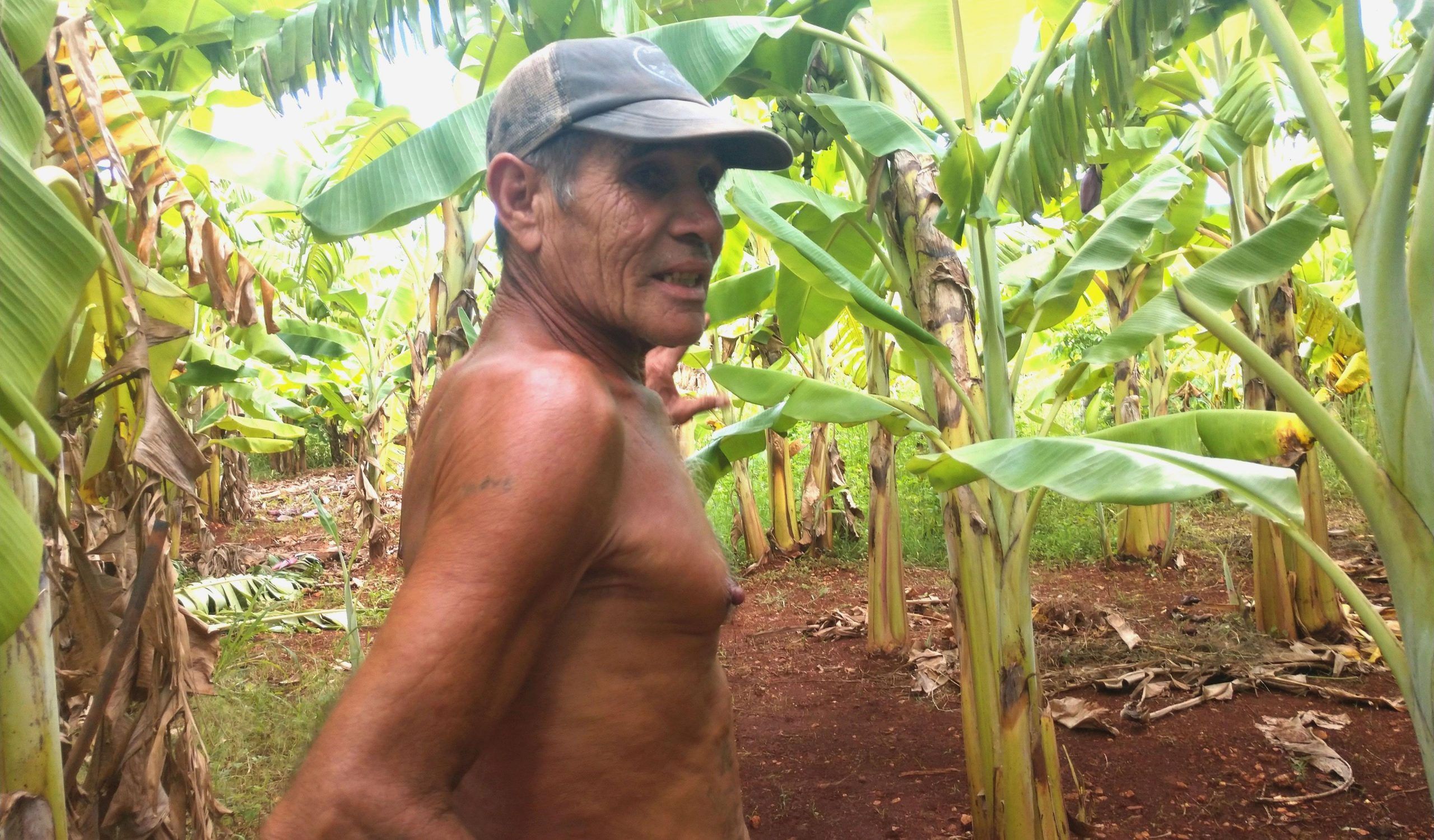
The well
Heberto tends a small piece of land near the well because Gladys Ferrales, his wife, is in charge of the well. The Company pays her to turn on the motor that brings the water to the building twice a day, and he sometimes does it for her. There he has planted bananas, tomatoes, peppers, papaya and even peanuts. With that he makes some money to support himself. The land is not his, but so far no one has said anything to him for planting it.
Sometimes the children bathe in the turbine to take advantage of the water pressure that overflows.
Gladys walks 300 meters from her house to the well and turns on the turbine. The belts break frequently, the community runs out of water and she has no peace of mind. Today she is collecting money from house to house to buy a new belt.
“We get them from other sources because the Company does not have this type of belts. There is a man who gets them, I don’t know where, but you have to pay him.”
To get to the well, you have to cross the school’s old sports area, an asphalt field where they used to play basketball in the past. Waste is dumped in that area, although the dump has no delimited space. Piles of broken nylon bags full of garbage cover the ground: labels from some packaging, chicken bones, used condoms, an old rag…
Heberto was in jail years ago for attempting to leave the country illegally, but now he wants to work to help his son, who is also in prison. He and Gladys have been married for more than thirthy-four years, since she ran away with him in Las Tunas, in the east of the country.
Gladys goes to the Pentecostal Church on Sundays, on Thursdays the brothers come to her house and several people from the community get together. She remembers that on the day of the staircase she could only thank God that Heberto was alive.
“The two floors of that block were cut off. The authorities and firefighters arrived to help in the rescue efforts. They had to modify several apartments and make an entrance through the building’s traditional staircase. Then they forgot about it and nothing more has happened, any day another staircase will fall down.”
Midnight shoes
At midnight the music stops. There is a momentary pause to sing the national anthem. It is September 28, 2019 and the 59th anniversary of the founding of the CDR is being celebrated. Everyone stands at attention and listens to Yakelín who thanks the Revolution for having given them these houses. There is no questioning, no resistance, no enthusiasm. After shouting Viva Fidel!, Viva la Revolución!, Vivan los CDR!, the party continues.
In Cuba, the Revolution is a leading character that accompanies, determines, excites or condemns. The Government, the Company and the Revolution are like synonyms that are accommodated according to what is being talked about. Politics, even in this place, is part of the ritual, it is omnipresent and determines, by action or omission, people’s lives and the way they behave. Even if only in a formal way.
The caldosa is ready. It is not a gastronomic jewel, it was not made to be served in a restaurant, but it allays the hunger and there is enough for everyone. The charcoal has imbued a smoky touch to the thick, yellowish broth with chunks of vegetables and it will depend on luck if you get any meat.

After a while, it is finally served. Everyone bring their bowl and receive a portion. It is boiling and smells appetizing. Most drink it there; others take it home for the next day.
Bajanda / Bajanda / Bajanda andaanada / Bajanda / Bajanda / Bajanda andanada
It is almost two in the morning. The party is running out of steam, it is on its last breath, but it resists ending. Some of the men present have tried to start several fights, but they are quickly resolved. More than twenty empty rum bottles pile up on the floor.
Yakelín’s shoes have been missing since midnight. No prince charming will pick them up.
Voʼ a dejarte tiesa y voʼ a echarme pieza ricamente / voʼ a hacer mi vida dignamente
The next day, the audio equipment, the pot, the bottles are still in place. The silence of the morning is just a recess.
In Melena del Sur the earth is red and its dust permeates clothes and hair. On the walls, each of different colors, the earth sticks and rises as if the field wanted to swallow the building.
Soon the music will start again.

*This work was elaborated in the New Narratives Workshop in Havana, led by Federico Mastrogiovanni and Sergio Rodríguez-Blanco, organized by TallerINN, Rosa Luxemburg Stiftung, Casa de las Américas and Ibero México-Tijuana, in collaboration with Programa Prende and perrocronico.com. Published simultaneously with Perro Crónico. @PerroCronico.
Editing: Sergio Rodríguez-Blanco / Federico Mastrogiovanni
Coedition: Ricardo López Cordero / Violeta Santiago




